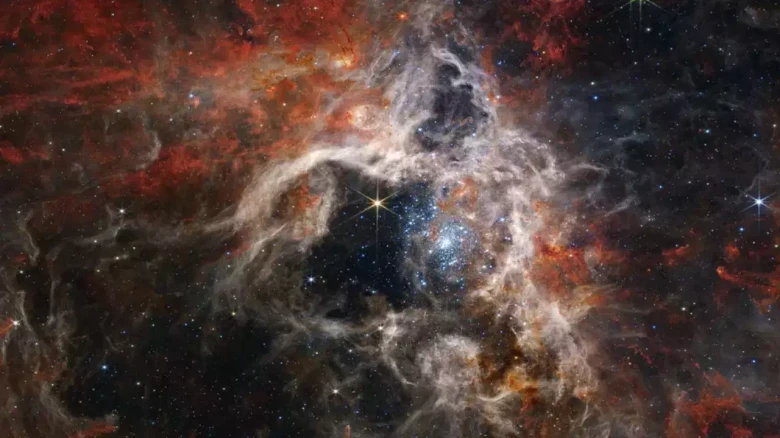North East

One young star was observed emitting a cloud of dust from around itself by Webb's Near-Infrared Spectrograph (NIRSpec), which analyses light patterns to ascertain the composition of objects.
color:black;mso-themecolor:text1">
color:black;mso-themecolor:text1">Digital Desk: NASA's Webb telescope has
photographed a stellar nursery known as the Tarantula Nebula in fine detail,
revealing previously unknown features that advance scientific knowledge, the
agency announced Tuesday.
color:black;mso-themecolor:text1">The area of space, officially known as 30
Doradus, has long been a favourite of astronomers who study star formation
because of its dusty filaments that resemble the legs of a hairy spider.
color:black;mso-themecolor:text1">Thanks to Webb's high-resolution infrared
detectors, thousands of young stars, distant background galaxies, and the
precise structure of the nebula's gas and dust components could all be seen for
the first time.
color:black;mso-themecolor:text1">Because light from far-off objects in the
cosmos has been compressed into this wavelength during the history of the
universe's expansion, Webb predominantly operates in the infrared spectrum.
color:black;mso-themecolor:text1">The Near-Infrared Camera (NIRCam), the
telescope's primary imager, discovered that radiation transported by stellar
winds emerging from a cluster of massive young stars, which appear as pale blue
spots, hollowed out the cavity in the nebula's center.
color:black;mso-themecolor:text1">One young star was observed emitting a cloud
of dust from around itself by Webb's Near-Infrared Spectrograph (NIRSpec),
which analyses light patterns to ascertain the composition of objects.
color:black;mso-themecolor:text1">The Mid-infrared Instrument (MIRI), which
uses longer infrared wavelengths to cut through dust grains that absorb or
scatter shorter wavelengths, also captured images of the area.
color:black;mso-themecolor:text1">This revealed never-before-seen spots of
light within the stellar nursery, which signify protostars that are still
developing mass. It also faded the hot stars and defined the cooler regions.
color:black;mso-themecolor:text1">The Tarantula Nebula has attracted
astronomical interest because of its chemical similarities to enormous
star-forming regions seen a few billion years after the Big Bang, during the
"cosmic noon," when star production peaked.
color:black;mso-themecolor:text1">Tarantula is a plainly observable example of
this blooming phase of cosmic formation and is only 161,000 light-years away.
In order to comprehend similarities and contrasts, Webb should give researchers
the chance to observe far-off galaxies from the actual cosmic midday epoch and
compare those views to Tarantula images.
color:black;mso-themecolor:text1">Astronomers are convinced that Webb, the most
potent space telescope ever built and in operation since July, will usher in a
new era of discovery.
color:black;mso-themecolor:text1">
color:black;mso-themecolor:text1">
color:black;mso-themecolor:text1">
color:black;mso-themecolor:text1">
color:black;mso-themecolor:text1">
Leave A Comment